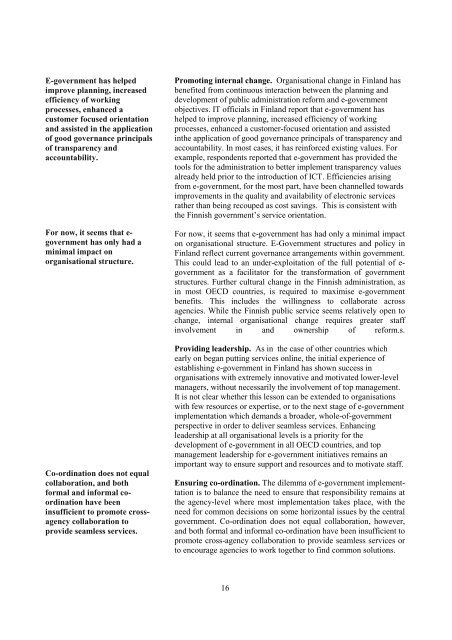e-GOVERNMENT IN FINLAND - ePractice.eu
e-GOVERNMENT IN FINLAND - ePractice.eu
e-GOVERNMENT IN FINLAND - ePractice.eu
You also want an ePaper? Increase the reach of your titles
YUMPU automatically turns print PDFs into web optimized ePapers that Google loves.
E-government has helped<br />
improve planning, increased<br />
efficiency of working<br />
processes, enhanced a<br />
customer focused orientation<br />
and assisted in the application<br />
of good governance principals<br />
of transparency and<br />
accountability.<br />
For now, it seems that egovernment<br />
has only had a<br />
minimal impact on<br />
organisational structure.<br />
Co-ordination does not equal<br />
collaboration, and both<br />
formal and informal coordination<br />
have been<br />
insufficient to promote crossagency<br />
collaboration to<br />
provide seamless services.<br />
Promoting internal change. Organisational change in Finland has<br />
benefited from continuous interaction between the planning and<br />
development of public administration reform and e-government<br />
objectives. IT officials in Finland report that e-government has<br />
helped to improve planning, increased efficiency of working<br />
processes, enhanced a customer-focused orientation and assisted<br />
inthe application of good governance principals of transparency and<br />
accountability. In most cases, it has reinforced existing values. For<br />
example, respondents reported that e-government has provided the<br />
tools for the administration to better implement transparency values<br />
already held prior to the introduction of ICT. Efficiencies arising<br />
from e-government, for the most part, have been channelled towards<br />
improvements in the quality and availability of electronic services<br />
rather than being recouped as cost savings. This is consistent with<br />
the Finnish government’s service orientation.<br />
For now, it seems that e-government has had only a minimal impact<br />
on organisational structure. E-Government structures and policy in<br />
Finland reflect current governance arrangements within government.<br />
This could lead to an under-exploitation of the full potential of egovernment<br />
as a facilitator for the transformation of government<br />
structures. Further cultural change in the Finnish administration, as<br />
in most OECD countries, is required to maximise e-government<br />
benefits. This includes the willingness to collaborate across<br />
agencies. While the Finnish public service seems relatively open to<br />
change, internal organisational change requires greater staff<br />
involvement in and ownership of reform.s.<br />
Providing leadership. As in the case of other countries which<br />
early on began putting services online, the initial experience of<br />
establishing e-government in Finland has shown success in<br />
organisations with extremely innovative and motivated lower-level<br />
managers, without necessarily the involvement of top management.<br />
It is not clear whether this lesson can be extended to organisations<br />
with few resources or expertise, or to the next stage of e-government<br />
implementation which demands a broader, whole-of-government<br />
perspective in order to deliver seamless services. Enhancing<br />
leadership at all organisational levels is a priority for the<br />
development of e-government in all OECD countries, and top<br />
management leadership for e-government initiatives remains an<br />
important way to ensure support and resources and to motivate staff.<br />
Ensuring co-ordination. The dilemma of e-government implementtation<br />
is to balance the need to ensure that responsibility remains at<br />
the agency-level where most implementation takes place, with the<br />
need for common decisions on some horizontal issues by the central<br />
government. Co-ordination does not equal collaboration, however,<br />
and both formal and informal co-ordination have been insufficient to<br />
promote cross-agency collaboration to provide seamless services or<br />
to encourage agencies to work together to find common solutions.<br />
16
















